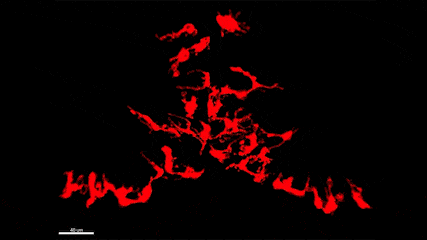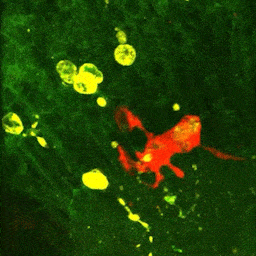
Centre de Neurophysique, Physiologie et Pathologie - CNRS UMR 8119
Université Paris Descartes
45 Rue des Saints Pères
75270 Paris Cedex 06
France
Fax : +33 (0) 1 42 86 20 80
Nadia Soussi-Yanicostas
Research Director, CNRS
MetaTox
MetaTox

Imaging of a live 5-day developmental zebrafish brain showing microglial cell dynamics and 3D reconstruction of a representative microglia (Nadia Soussi-Yanicostas’s team).

Video showing phagocytosis of apoptotic cells by microglia in real time in the brain of a 4-day-old zebrafish embryo. Microglia (red) catches dead cells (yellow) by its extensions and then digests them to cleanse the brain (Nadia Soussi-Yanicostas’team).
Recent works
We demonstrated that there is a shift of the synaptic balance in favor of excitation in the brains of three different zebrafish mutants that exhibit epileptiform seizures; scn1Lab (Brenet A. et al. Cells 2019), gabra1 (Samarut E. et al. Epilepsia 2018) and depdc5 (Swaminathan A. et al. Curr. Biol. 2018). During our work on the scn1Lab mutant, we also showed the perfect correlation between electroencephalographic recordings of brain activity and in vivo calcium imaging (Brenet A. et al. Cells 2019). Using an in vivo model of neuroinflammation in zebrafish embryo, we first showed that carbetocin, an oxytocin analogue, has strong anti-inflammatory effects via its action on microglia (Mairesse J. et al. Glia 2019). More recently, we have shown that this oxytocin analog reduces the number and intensity of seizures in scn1Lab embryos via its anti-inflammatory action on microglia (Brenet A. et al. In prep). We have developed the first zebrafish model of poisoning with DFP, an organophosphate close to the nerve gas sarin. We thus confirmed the neurotoxicity of this compound as well as its epileptogenic effects (Brenet A. et al. Sci. Rep. 2020), which induce massive neuroinflammation of microglia (Maupu C. et al. Neurobiol. Dis. 2021; Somkhit J. et al. Int. J. Mol. Sci. 2022). We are currently testing new molecules protecting against organophosphate poisoning. We have shown that bixafen, a succinate dehydrogenase inhibitor (SDHi) family fungicide widely used by farmers, exhibits developmental neurotoxicity for the zebrafish embryo at environmentally relevant doses. This toxicity results in microcephaly and disorganization of motor axons (Brenet A. et al. Chemosphere 2021). These results were the subject of a press release in the CNRS journal (CNRS, News 11/6/2020) and an article in the daily Le Monde on 11/21/2020. Finally, this work and the dangers represented by SDHis, the toxicity of which remains little studied, led us to review all toxicology studies of SDHis carried out to date in zebrafish (Yanicostas C. and Soussi-Yanicostas N. Int J. Mol. Sci. 2021). In line with this work, we are currently studying the transgenerational effects of these pesticides and the epigenetic modifications involved. More recently, we showed for the first time in vivo that epileptiform seizures in the scn1Lab mutant induce neuroinflammation of microglial origin, but above all, that in the absence of microglia, the seizures are more intense and more frequent, indicating that despite the neuroinflammation they induce, microglia have a neuroprotective role (Brenet A. et al. In prep. hal-03745018v2). We are currently investigating the response of microglia to epileptiform seizures using the gabrg2 mutant in which seizures are light-inducible, making it possible to monitor in vivo the dynamics of the response of these cells to seizures. At the technological level, we have developed a simple and inexpensive method that allows real-time measurement of O2 consumption in living zebrafish embryos (Somkhit J. et al. Zebrafish 2020).
Journal articles
2024
- ref_biblio
- Alexandre Brenet, Julie Somkhit, Zsolt Csaba, Sorana Ciura, Edor Kabashi, et al.. Microglia Mitigate Neuronal Activation in a Zebrafish Model of Dravet Syndrome. Cells, 2024, 13 (8), pp.684. ⟨10.3390/cells13080684⟩. ⟨hal-04750420v5⟩
- Accès au texte intégral et bibtex
-


- ref_biblio
- Laís Cintra, Constantin Yanicostas, Nadia Soussi-Yanicostas, Claudia Vianna Maurer-Morelli. Effects of baicalin pre-treatment on pentylenetetrazole-induced seizures: Insights from zebrafish larvae locomotor behavior and neuronal calcium imaging. Epilepsy & Behavior, 2024, 157, pp.109866. ⟨10.1016/j.yebeh.2024.109866⟩. ⟨hal-04749446⟩
- Accès au texte intégral et bibtex
-


2022
- ref_biblio
- Julie Somkhit, Constantin Yanicostas, Nadia Soussi-Yanicostas. Microglia Remodelling and Neuroinflammation Parallel Neuronal Hyperactivation Following Acute Organophosphate Poisoning. International Journal of Molecular Sciences, 2022, 23 (15), pp.8240. ⟨10.3390/ijms23158240⟩. ⟨hal-03873288⟩
- Accès au texte intégral et bibtex
-


- ref_biblio
- Nadia Soussi-Yanicostas. Zebrafish as a Model for Neurological Disorders. International Journal of Molecular Sciences, 2022, 23 (8), pp.4321. ⟨10.3390/ijms23084321⟩. ⟨hal-03738788⟩
- Accès au texte intégral et bibtex
-


2021
- ref_biblio
- Clémence Maupu, Julie Enderlin, Alexandre Igert, Myriam Oger, Stéphane Auvin, et al.. Diisopropylfluorophosphate-induced status epilepticus drives complex glial cell phenotypes in adult male mice. Neurobiology of Disease, 2021, 152, pp.105276. ⟨10.1016/j.nbd.2021.105276⟩. ⟨hal-03271712⟩
- Accès au texte intégral et bibtex
-


- ref_biblio
- Constantin Yanicostas, Nadia Soussi-Yanicostas. SDHI Fungicide Toxicity and Associated Adverse Outcome Pathways: What Can Zebrafish Tell Us?. International Journal of Molecular Sciences, 2021, 22 (22), pp.12362. ⟨10.3390/ijms222212362⟩. ⟨hal-03433483⟩
- Accès au texte intégral et bibtex
-


- ref_biblio
- Constantin Yanicostas, Nadia Soussi-Yanicostas. SDHI Fungicide Toxicity and Associated Adverse Outcome Pathways: What Can Zebrafish Tell Us?. International Journal of Molecular Sciences, 2021, 22 (22), ⟨10.3390/ijms222212362⟩. ⟨hal-03451260⟩
- Accès au texte intégral et bibtex
-


2020
- ref_biblio
- Alexandre Brenet, Rahma Hassan-Abdi, Nadia Soussi-Yanicostas. Bixafen, a succinate dehydrogenase inhibitor fungicide, causes microcephaly and motor neuron axon defects during development. Chemosphere, 2020, pp.128781. ⟨10.1016/j.chemosphere.2020.128781⟩. ⟨inserm-03058531⟩
- Accès au texte intégral et bibtex
-


- ref_biblio
- Alexandre Brenet, Julie Somkhit, Rahma Hassan-Abdi, Constantin Yanicostas, Christiane Romain, et al.. Organophosphorus diisopropylfluorophosphate (DFP) intoxication in zebrafish larvae causes behavioral defects, neuronal hyperexcitation and neuronal death. Scientific Reports, 2020, 10 (1), pp.19228. ⟨10.1038/s41598-020-76056-8⟩. ⟨inserm-03058521⟩
- Accès au texte intégral et bibtex
-


- ref_biblio
- Alexandre Brenet, Julie Somkhit, Rahma Hassan-Abdi, Nadia Soussi-Yanicostas, Christiane Romain, et al.. Organophosphorus diisopropylfluorophosphate (DFP) intoxication in zebrafish larvae causes behavioral defects, neuronal hyperexcitation and neuronal death. Scientific Reports, 2020, 10 (1), ⟨10.1038/s41598-020-76056-8⟩. ⟨hal-03449176⟩
- Accès au bibtex
-

- ref_biblio
- Julie Somkhit, Roxane Loyant, Alexandre Brenet, Rahma Hassan-Abdi, Constantin Yanicostas, et al.. A Fast, Simple, and Affordable Technique to Measure Oxygen Consumption in Living Zebrafish Embryos. Zebrafish, 2020, 17 (4), pp.268-270. ⟨10.1089/zeb.2020.1878⟩. ⟨hal-03097083⟩
- Accès au texte intégral et bibtex
-


2019
- ref_biblio
- Alexandre Brenet, Rahma Hassan-Abdi, Julie Somkhit, Constantin Yanicostas, Nadia Soussi-Yanicostas. Defective Excitatory/Inhibitory Synaptic Balance and Increased Neuron Apoptosis in a Zebrafish Model of Dravet Syndrome. Cells, 2019, 8 (10), pp.1199. ⟨10.3390/cells8101199⟩. ⟨hal-02357182⟩
- Accès au texte intégral et bibtex
-


- ref_biblio
- Rahma Hassan-Abdi, Alexandre Brenet, Mohamed Bennis, Constantin Yanicostas, Nadia Soussi-Yanicostas. Neurons Expressing Pathological Tau Protein Trigger Dramatic Changes in Microglial Morphology and Dynamics. Frontiers in Neuroscience, 2019, 13, ⟨10.3389/fnins.2019.01199⟩. ⟨hal-02357184⟩
- Accès au texte intégral et bibtex
-


- ref_biblio
- Jérôme Mairesse, Manuela Zinni, Julien Pansiot, Rahma Hassan-Abdi, Charlie Demené, et al.. Oxytocin receptor agonist reduces perinatal brain damage by targeting microglia. Glia, 2019, 67 (2), pp.345-359. ⟨10.1002/glia.23546⟩. ⟨inserm-04075780⟩
- Accès au texte intégral et bibtex
-


- ref_biblio
- Juliette van Steenwinckel, Anne-Laure Schang, Michelle L Krishnan, Vincent Degos, Andrée Delahaye-Duriez, et al.. Decreased microglial Wnt/β-catenin signalling drives microglial pro-inflammatory activation in the developing brain. Brain - A Journal of Neurology , 2019, 42 (12), pp.3806-3833. ⟨10.1093/brain/awz319⟩. ⟨hal-02357196⟩
- Accès au texte intégral et bibtex
-


2018
- ref_biblio
- Stéphane Auvin, Mohamed Jeljeli, Béatrice Desnous, Nadia Soussi-Yanicostas, Pascal Dournaud, et al.. Altered vaccine-induced immunity in children with Dravet syndrome. Epilepsia, 2018, 59 (4), pp.e45-e50. ⟨10.1111/epi.14038⟩. ⟨hal-02357179⟩
- Accès au texte intégral et bibtex
-


- ref_biblio
- Seyedeh Maryam Alavi Naini, Nadia Soussi-Yanicostas. Heparan Sulfate as a Therapeutic Target in Tauopathies: Insights From Zebrafish. Frontiers in Cell and Developmental Biology, 2018, 6, ⟨10.3389/fcell.2018.00163⟩. ⟨hal-02357169⟩
- Accès au texte intégral et bibtex
-


- ref_biblio
- Seyedeh Maryam Alavi Naini, Constantin Yanicostas, Rahma Hassan-Abdi, Sébastien Blondeel, Mohamed Bennis, et al.. Surfen and oxalyl surfen decrease tau hyperphosphorylation and mitigate neuron deficits in vivo in a zebrafish model of tauopathy. Translational Neurodegeneration, 2018, 7 (1), pp.6. ⟨10.1186/s40035-018-0111-2⟩. ⟨inserm-01736589⟩
- Accès au texte intégral et bibtex
-


- ref_biblio
- Eric Samarut, Amrutha Swaminathan, Raphaëlle Riché, Meijiang Liao, Rahma Hassan-Abdi, et al.. γ-Aminobutyric acid receptor alpha 1 subunit loss of function causes genetic generalized epilepsy by impairing inhibitory network neurodevelopment. Epilepsia, 2018, 59 (11), pp.2061-2074. ⟨10.1111/epi.14576⟩. ⟨hal-02357189⟩
- Accès au texte intégral et bibtex
-


- ref_biblio
- Amrutha Swaminathan, Rahma Hassan-Abdi, Solène Renault, Aleksandra Siekierska, Raphaëlle Riché, et al.. Non-canonical mTOR-Independent Role of DEPDC5 in Regulating GABAergic Network Development. Current Biology, 2018, 28 (12), pp.1924-1937.e5. ⟨10.1016/j.cub.2018.04.061⟩. ⟨hal-02364352⟩
- Accès au texte intégral et bibtex
-


2015
- ref_biblio
- Julia Elisa Sepulveda-Diaz, Seyedeh Maryam Alavi Naini, Minh Bao Huynh, Mohand Ouidir Ouidja, Constantin Yanicostas, et al.. HS3ST2 expression is critical for the abnormal phosphorylation of tau in Alzheimer’s disease-related tau pathology. Brain - A Journal of Neurology , 2015, 138 (5), pp.1339--1354. ⟨10.1093/brain/awv056⟩. ⟨hal-05043357⟩
- Accès au bibtex
-

2013
- ref_biblio
- Jamal Ghoumid, Loïc Drevillon, Seyedeh Maryam Alavi-Naini, Nadège Bondurand, Marlène Rio, et al.. ZEB2 zinc-finger missense mutations lead to hypomorphic alleles and a mild Mowat–Wilson syndrome. Human Molecular Genetics, 2013, 22 (13), pp.2652-2661. ⟨10.1093/hmg/ddt114⟩. ⟨inserm-04135856⟩
- Accès au texte intégral et bibtex
-


2009
- ref_biblio
- Constantin Yanicostas, Eric Herbomel, Aurélie Dipietromaria, Nadia Soussi-Yanicostas. Anosmin-1a is required for fasciculation and terminal targeting of olfactory sensory neuron axons in the zebrafish olfactory system. Molecular and Cellular Endocrinology, 2009, 312 (1-2), pp.53. ⟨10.1016/j.mce.2009.04.017⟩. ⟨hal-00518309⟩
- Accès au texte intégral et bibtex
-


2008
- ref_biblio
- Ana Bribian, Pedro Esteban, Diego Clemente, Nadia Soussi-Yanicostas, Jean-Leon Thomas, et al.. A novel role for anosmin-1 in the adhesion and migration of oligodendrocyte precursors. Developmental Neurobiology, 2008, 68 (13), pp.1503 - 1516. ⟨10.1002/dneu.20678⟩. ⟨hal-01936170⟩
- Accès au bibtex
-

- ref_biblio
- Constantin Yanicostas, Sylvain Ernest, Cyrielle Dayraud, Christine Petit, Nadia Soussi-Yanicostas. Essential requirement for zebrafish anosmin-1a in the migration of the posterior lateral line primordium.. Developmental Biology, 2008, 320 (2), pp.469-79. ⟨10.1016/j.ydbio.2008.06.008⟩. ⟨inserm-00289099⟩
- Accès au texte intégral et bibtex
-


2003
- ref_biblio
- Tammy Dellovade, Jean-Pierre Hardelin, Nadia Soussi-Yanicostas, Donald Pfaff, Marlene Schwanzel-Fukuda, et al.. Anosmin-1 immunoreactivity during embryogenesis in a primitive eutherian mammal. Developmental Brain Research, 2003, 140 (2), pp.157-167. ⟨10.1016/s0165-3806(02)00544-8⟩. ⟨pasteur-05026600⟩
- Accès au bibtex
-

- ref_biblio
- Catherine Dodé, Jacqueline Levilliers, Jean-Michel Dupont, Anne de Paepe, Nathalie Le Dû, et al.. Loss-of-function mutations in FGFR1 cause autosomal dominant Kallmann syndrome. Nature Genetics, 2003, 33 (4), pp.463-465. ⟨10.1038/ng1122⟩. ⟨pasteur-05017424⟩
- Accès au bibtex
-

2002
- ref_biblio
- Nadia Soussi-Yanicostas, Fernando de Castro, A.Karyn Julliard, Isabelle Perfettini, Alain Chédotal, et al.. Anosmin-1, Defective in the X-Linked Form of Kallmann Syndrome, Promotes Axonal Branch Formation from Olfactory Bulb Output Neurons. Cell, 2002, 109 (2), pp.217-228. ⟨10.1016/s0092-8674(02)00713-4⟩. ⟨pasteur-05017662⟩
- Accès au bibtex
-

1999
- ref_biblio
- Jean-Pierre Hardelin, A Julliard, B Moniot, Nadia Soussi-Yanicostas, C Verney, et al.. Anosmin-1 is a regionally restricted component of basement membranes and interstitial matrices during organogenesis: implications for the developmental anomalies of X chromosome-linked Kallmann syndrome.. Developmental Dynamics, 1999, 215 (1), pp.26-44. ⟨pasteur-05025252⟩
- Accès au bibtex
-

1998
- ref_biblio
- Jean-Pierre Hardelin, Jacqueline Levilliers, Nadia Soussi-Yanicostas, Sonia Abdelhak, Vasiliki Kalatzis, et al.. Approche moléculaire de la pathogénie des anomalies rénales dans le syndrome de Kallmann de Morsier et dans le syndrome branchio-oto-rénal. Actualités néphrologiques Jean Hamburger, 1998, pp.333-340. ⟨pasteur-05027508⟩
- Accès au bibtex
-

- ref_biblio
- Jean-Pierre Hardelin, N. Soussi-Yanicostas, Jacqueline Levilliers, Vasiliki Kalatzis, Sonia Abdelhak, et al.. Molecular approach to the pathogenesis of renal anomalies in Kallmann's syndrome and in the branchio-oto-renal syndrome. Advances in Nephrology from the Necker Hospital, 1998, 28, pp.419-428. ⟨hal-04027337⟩
- Accès au bibtex
-

- ref_biblio
- Nadia Soussi-Yanicostas, Catherine Faivre-Sarrailh, Jean-Pierre Hardelin, Jacqueline Levilliers, Geneviève Rougon, et al.. Anosmin-1 underlying the X chromosome-linked Kallmann syndrome is an adhesion molecule that can modulate neurite growth in a cell-type specific manner. Journal of Cell Science, 1998, 111 (19), pp.2953-2965. ⟨10.1242/jcs.111.19.2953⟩. ⟨pasteur-05021074⟩
- Accès au bibtex
-

1995
- ref_biblio
- Nadia Soussi-Yanicostas, Jean-Pierre Hardelin, Jacqueline Levilliers, Olivier Ardouin, Renaud Legouis, et al.. Approche moléculaire de la pathogénie d'un deficit héréditaire de l'olfaction : Le syndrome de Kallmann de Morsier lie au chromosome X. Annales de l'Institut Pasteur/Actualités, 1995, 6 (4), pp.282-291. ⟨10.1016/0924-4204(96)83385-3⟩. ⟨hal-04027366⟩
- Accès au bibtex
-

Book sections
2000
- ref_biblio
- Jean-Pierre Hardelin, Nadia Soussi-Yanicostas, O. Ardouin, Jacqueline Levilliers, Christine Petit. Kallmann Syndrome. Advances in Oto-Rhino-Laryngology Genetics in Otorhinolaryngology, 56, KARGER, pp.268-274, 2000, 978-3-8055-6956-9. ⟨10.1159/000059073⟩. ⟨pasteur-05026776⟩
- Accès au bibtex
-

Patents
2013
- ref_biblio
- Dulce Papy-Garcia, Minh Bao Huynh, Nadia Soussi-Yanicostas, Fernando Siñeriz, Constantin Yanicostas, et al.. Method of Diagnosis, Prognostic or Treatment of Neurodegenerative Diseases. France, Patent n° : WO/2013/053954. 2013. ⟨hal-05020579⟩
- Accès au bibtex
-

